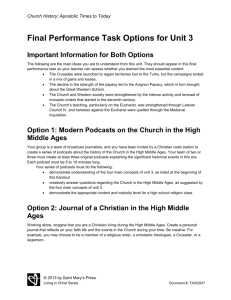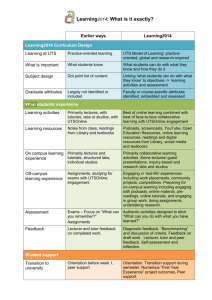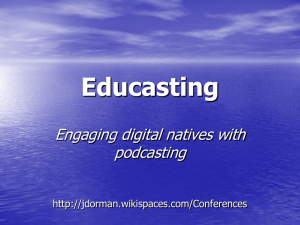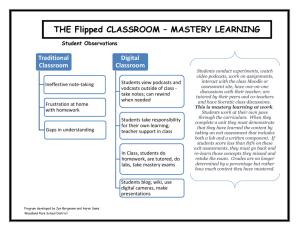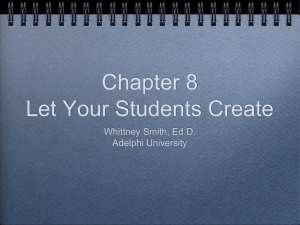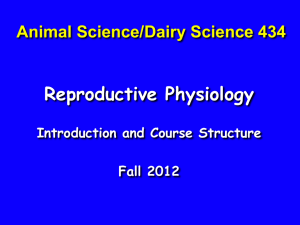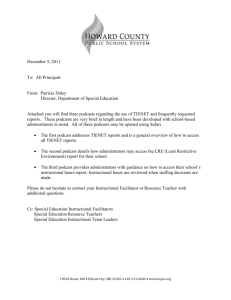The Potential Use of Mobile Devices in Higher Education
advertisement
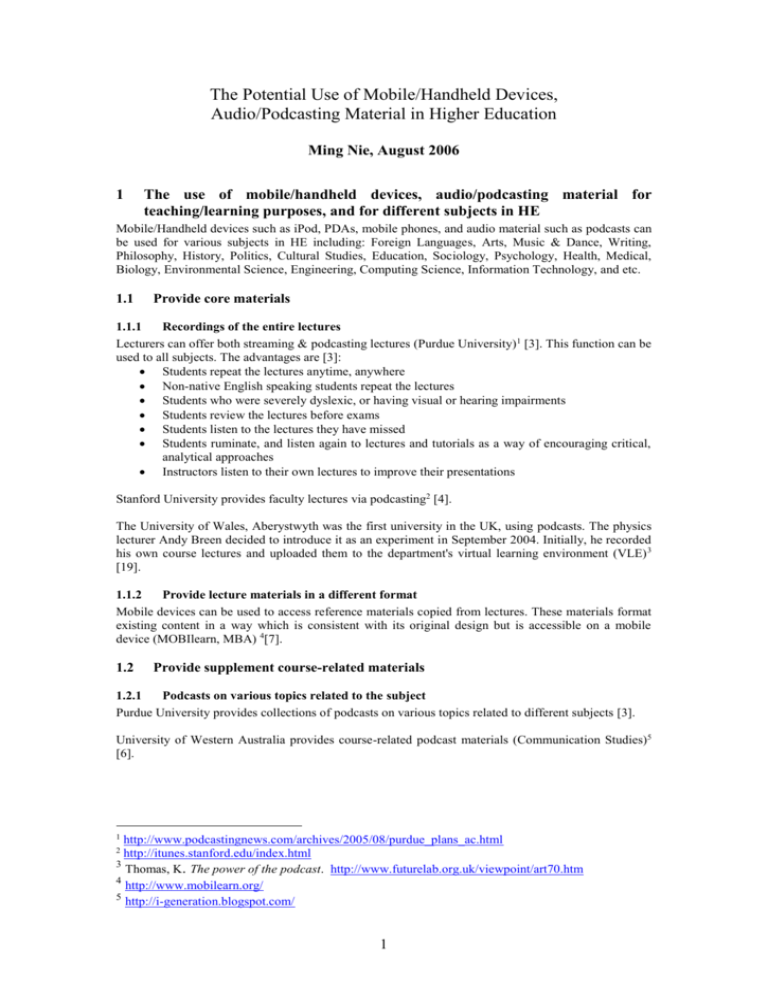
The Potential Use of Mobile/Handheld Devices, Audio/Podcasting Material in Higher Education Ming Nie, August 2006 1 The use of mobile/handheld devices, audio/podcasting material for teaching/learning purposes, and for different subjects in HE Mobile/Handheld devices such as iPod, PDAs, mobile phones, and audio material such as podcasts can be used for various subjects in HE including: Foreign Languages, Arts, Music & Dance, Writing, Philosophy, History, Politics, Cultural Studies, Education, Sociology, Psychology, Health, Medical, Biology, Environmental Science, Engineering, Computing Science, Information Technology, and etc. 1.1 Provide core materials 1.1.1 Recordings of the entire lectures Lecturers can offer both streaming & podcasting lectures (Purdue University)1 [3]. This function can be used to all subjects. The advantages are [3]: Students repeat the lectures anytime, anywhere Non-native English speaking students repeat the lectures Students who were severely dyslexic, or having visual or hearing impairments Students review the lectures before exams Students listen to the lectures they have missed Students ruminate, and listen again to lectures and tutorials as a way of encouraging critical, analytical approaches Instructors listen to their own lectures to improve their presentations Stanford University provides faculty lectures via podcasting2 [4]. The University of Wales, Aberystwyth was the first university in the UK, using podcasts. The physics lecturer Andy Breen decided to introduce it as an experiment in September 2004. Initially, he recorded his own course lectures and uploaded them to the department's virtual learning environment (VLE) 3 [19]. 1.1.2 Provide lecture materials in a different format Mobile devices can be used to access reference materials copied from lectures. These materials format existing content in a way which is consistent with its original design but is accessible on a mobile device (MOBIlearn, MBA) 4[7]. 1.2 Provide supplement course-related materials 1.2.1 Podcasts on various topics related to the subject Purdue University provides collections of podcasts on various topics related to different subjects [3]. University of Western Australia provides course-related podcast materials (Communication Studies)5 [6]. 1 http://www.podcastingnews.com/archives/2005/08/purdue_plans_ac.html http://itunes.stanford.edu/index.html 3 Thomas, K. The power of the podcast. http://www.futurelab.org.uk/viewpoint/art70.htm 4 http://www.mobilearn.org/ 5 http://i-generation.blogspot.com/ 2 1 1.2.2 Authentic audio materials Duke University provides recordings of textbook materials, journals, songs, music, vocabulary, novels, stories, poems, radio programs, subscribed podcasts distributed by media source, oral history interviews, authentic speeches by notable figures, congressional debates, etc. These listening materials can be widely used for subjects such as Foreign Languages, History, Politics, Writing, Arts, Music [1]. In GCSU (Georgia College & State University), iPods allow students to listen to audio content on the web, subscribed podcasts, pre-loaded language tutorials, recordings of diction sessions with native speakers, audio books, literature, TV/radio newscasts, assigned selections of music, live recordings of rehearsals and concerts. These audio materials are used for various subjects: Education, Psychology, Music, History, Sociology, Foreign Languages [2]. In University of Mary Washington, the professor reads poems through podcasts to help students overcome obstacles of language and syntax (Foreign Languages) [8]. Students can record lectures, teacher’s notes, meeting and conference notes with teachers/students, student oral report, student project support interviews for different subjects (University of Missouri) [12]. 1.2.3 Provide pre-class listening materials Students listen to “Mini lectures” via podcasting before class containing contextualized information about the readings, collections of audio lectures, and questions posed by the lecturer for students to think about before class (Duke University, Philosophy) [1]. Students listen to podcasts before class containing news of the week, activities students are expected to do, comments and feedback on assignments and E-tivities, and jokes (University of Leicester, Electrical Engineering) [9]. Students use podcasts to explain what they hope to accomplish in their presentations, and read aloud brief excerpts from the assigned readings to help others understand easily (University of Mary Washington, Philosophy) [8]. The professor use podcasts to summarize several journal articles related to the subject (University of Mary Washington, Biology) [8]. Students listen to podcasts before class containing background materials of the subject and terminology used in the subject, e.g. computing jargon. The podcasts are used as a strategy for addressing students’ preconceptions and anxiety to better prepare them for effective face-to-face learning. They think of adding music to enhance preclass listening materials, using podcasts for revision and reinforcement purposes, and sharing student-generated podcasts for knowledge construction (Charles Sturt University, Computing Science) [10]. Student-generated podcasts contain 2 or more students’ discussions on pertinent issues related to the subject matter (Charles Sturt University, Information Technology) [11]. Students of Charles Sturt University thought that podcasts can be used to address their problems related to time management, how to follow the course content and take notes, fear of missing content, fear of not being about to talk to anyone, social aspects of the subject and assignment details and submission procedures (Computing Science) [10]. 1.2.4 Access multimedia materials With video enhanced iPod, students can access a visual glossary of human neuroanatomy. This glossary comprises 500 structures and terms. For each term, students can access a description of the term, information on brain structure, location and function, audio pronunciation, links to related terms and high quality brain imagines optimized for the iPod photo display (Duke University, Psychology) [1]. With video enhanced iPod, students can access a visual glossary of the human brain and spinal cord. This resource contains information on more than 400 neuroanatomical structures and terms. Students 2 use it for specific assignments and to facilitate the learning of human central nervous system anatomy. Students can also watch a brain dissection video via iPod (GCSU, Psychology) [2]. With video enhanced iPod, students can view masterworks of world cinema, listen to music, view paintings and hear presentations at the same time (GCSU, Arts and History) [2]. With video enhanced iPod, students can listen to assigned music while using the text notes function to learn about the social setting and political climate of the era of composition or read biographical information about composers and musicians (GCSU, Music and Dance) [2]. Mobile devices can provide students with a series of interactive exercises based entirely around question and answer activities with supporting information and images (MOBIlearn, First Aider in Health) [7]. Mobile devices can provide users with different sets of information for different locations by using rich media (MOBIlearn, Multimedia Museum) [7]. Users can display the works and hear the information about the works, comments from the author and photographer (GCSU, Multimedia Exhibit) [2]. Handheld devices such as PDAs allow Healthcare students to access a wide range of multimedia resources related to clinical information and tools e.g. administrative functions (scheduling, address book…), electronic textbooks, prescription information, medical calculators, photography, memo, medical records, patient tracking, etc. and learning activities and tools e.g. access Internet, dictation, evidence-based medicine tools, in-house documentation system, etc. (Healthcare in Community) [13]. PDAs allow students to access course syllabus, online grade books (post student grade), personal profile (store information to share with others), team space (facilitate the collaborations among team members), video classroom (watch lectures live), etc. (Indiana University). 1.2.5 Access administrative information Students use SMS messaging to access information about lectures and classes, and corrections in the schedule. [16]. 1.3 Produce student presentation, assignment and project Handheld devices such as iPod can be used by students to store, transfer, import, archive and display photographs and large files for presentation and multimedia projects or assignments. This function can be used for various subjects: Arts, Writing, Politics, Computing Science, Information Science (Duke University) [1]. Handheld devices can be used to record student discussion sessions or tutoring sessions, and use podcasts to share comments and summaries to discussions. This function can be used for various subjects, e.g. Education, Writing, Philosophy, Information Science, etc (Duke University) [1]. Students record their own conclusions based on interviews, record their summaries based on weekly group blogs, and make them available to others via podcasting (GUCS, Education and Pschology) [2]. Students produce their own podcasts on various areas of historical research including biography, local history, oral history, etc (GUCS, History) [2]. Students create enhanced podcast presentations on assigned readings (e.g. offering imaginative and innovative tour of places mentioned in the book) (GUCS, Arts) [2]. Students produce their final project – composition (GUCS, Music and Dance) [2]. 3 1.4 Facilitate field studies 1.4.1 Record interviews with field informants Mobile/Handheld devices can be use to record student interviews with field informants. This function can be used for various subjects: Cultural Studies, Foreign Languages, Environmental Science, Arts, Writing (Duke University) [1], Education (GCSU) [2]. PDAs allow students to record result of public opinions or investigations in local community (Sociology) [18]. 1.4.2 Record field notes and personal observations PDAs allow students to capture data during care of the patient. They allow data to be aggregated for decision-making (Columbia University, Medical) [17] Handheld devices such as PDAs allow amateur naturalists or students learning science to keep track of their observations [14]. 1.4.3 Access pre-loaded information related to the field study/trip PDAs with preloaded information such as field guide and note books allow students to refer to during their trip or field study (Biology, Ecotourism Management) [14]. PDAs with preloaded materials relevant to a particular exhibit help students to learn more during a museum trip (Science) [14]. 1.4.4 Access database and compare data collected Handheld devices such as PDAs provide amateur naturalists or students learning science the ability to connect with a database and compare their data [14]. 1.5 Evaluation (tutor evaluation, peer evaluation, self-evaluation) Handheld devices such as iPod can be used by students to record their own reading, presentation, speaking assignment, oral examination, group discussion for tutor evaluation, peer evaluation or selfevaluation. This function can be used for different subjects: Foreign Languages, Oral Communication, Academic Presentations, Writing (Duke University) [1]. With enhanced video iPod, students can view their taped conducting performances for self-evaluation (GCSU, Music and Dance) [2]. Students produce their podcast assignments for assessment (University of Western Australia, Communication Studies) [6]. Students record interviews with each other (in podcasts) using foreign languages for peer evaluation or self-evaluation (University of Mary Washington, Foreign Languages) [8]. PDAs allow supervisors to conduct onsite student assessment, record information about students and create lesson plans (Teacher Education) [17]. Students record and upload their foreign language lessons in podcasts format to their instructor’s website so their instructor can listen and give evaluation (University of Missouri, Foreign Languages) [12]. 1.6 Access practical exercises Mobile phones with online services allow students to access multiple choice questions and answers, and practical exercises for TOEIC (Test of English for International Communication) (Foreign Languages) [15]. Mobile devices allow students to review, listen and practice speaking, and provide services such as phrase translation, quizzes and live coaching (Stanford Learning Lab, Foreign Languages) [20]. 4 1.7 Provide feedback on student work/questions Handheld devices such as iPod can be used by tutors to record feedback on student assessment such as oral exams (Duke University, Foreign Languages) [1]. iPod allows lecturers to provide weekly podcasts based on “muddy points” students posed via email (GCSU, Psychology) [2]. 2 2.1 The use of mobile/handheld devices, audio/podcast material for other purposes in HE Support student social life Podcasts can be used to provide and distribute information on various aspects of student social life. For example, Purdue University provides podcasts on all kinds of information related to student social life [3]. 2.1.1 Career Centre Produce podcasts based on other people’s career stories (GCSU) [2] 2.1.2 Entertainment Provide entertaining materials such as music and sports (Stanford University) [4] Distribute sport events (University of Missouri) [12] 2.1.3 Information within a community Provide advising content for Stanford community (Stanford University) [4] Distribute news broadcasts (University of Missouri) [12] Distribute bus schedule and weather report (Indiana University). 2.1.4 Campus orientation Students of Charles Sturt University thought that podcasts can be used as campus orientation to first year students [10]. 2.1.5 Prepare international students for living/studying in the UK Podcasts are used as part of “the Arrive UK” toolkit for international students. The podcasts are based on different themes such as travel stories and experiences, and tutors’ tips concerning specific academic skills e.g. the best ways to approach academic reading and note-taking. The e-tutor sets various listening comprehension tasks in relation to the podcasts and these also formed the staring point for a number of the discussion board activities (University of Southampton) [5]. 2.2 Staff development/training Handheld devices such as iPod can be used by lecturers/tutors to record student experience with the lecturer/tutor, record lecturer/tutor’s reflection on their own work, record selected sessions, students’ brainstorming discussion, and their own sessions for training and reflection purposes (Duke University) [1]. Staff develop podcasts on various topics such as assessment, how to promote discussion in the classroom, teaching with technology, gender and cross-cultural issues in the classroom, scholarship, book reviews, teaching/learning resources, etc. for staff development and training purposes (GCSU)[2]. Podcasts can be used to produce content such as how to use CETL resources for new staff (GCSU) [2]. Staff produce podcasts based on an open discussion on selected articles from various disciplines (GCSU) [2]. 5 2.3 Student recruitment The University produces podcasts providing information to prospective students (GCSU) [2]. Audio/video (podcasting/vodcasting) can be used to provide recruiting brochures with personalized messages for prospective students and parents (University of Missouri) [12]. 3 3.1 Summary The use of mobile/handheld devices for learning/teaching purposes in HE Mobile/handheld devices are widely used for subjects e.g. Foreign Languages, Arts, Music, Writing, History, Politics, Sociology, Education, Medical, Health. Mobile/handheld devices are used in the following areas to support teaching/learning: Students record interviews with informants Students record their own works e.g. oral examination, oral report, presentation, group discussion, etc. for tutor evaluation, peer evaluation, and self-evaluation. Students listen to authentic audio materials e.g. music, speech, interview, vocabulary, audio book, poem, etc. Students access multimedia materials e.g. movie, painting, photograph, documentary, visual glossary, etc. Students refer to preloaded information in a field trip or field study. Students produce their multimedia presentation, assignment, and project. There is a need to build an extensive library including music, image, artwork, architecture, literature, movie, speech, etc for mobile device use. 3.2 The potential use of podcasts for learning/teaching purposes in HE Podcasts can be used in different subjects. They have the potential to be used in the following areas to support teaching/learning: Lecturer-generated pre-class listening materials containing news, review of journal articles, activities of the week, feedback and comments on assignment and activities, explanation of difficult terms, background information about the subject, questions students need to think about before class, etc. Student-generated podcasts based on student own summaries, reflections, comments, thoughts, and conclusions. The purpose is to share student own ideas with others via podcasting. Reference: [1] http://cit.duke.edu/about/ipod_faculty_projects_fall05.do#downstream [2] http://ipod.gcsu.edu/ [3] http://www.podcastingnews.com/archives/2005/08/purdue_plans_ac.html [4] http://itunes.stanford.edu/index.html [5] http://www.elanguages.ac.uk/toolkits/arriveuk.htm [6] http://i-generation.blogspot.com/ [7] http://www.mobilearn.org/ [8] Campbell, G. (2005). There’s Something in the Air: Podcasting in Education. EDUCAUSE Review 40 (6), 32-47. http://www.educause.edu/apps/er/erm05/erm0561.asp [9] Edirisingha, P., Salmon, G., & Fothergill, J. (2006). Profcasting: a pilot study and a model for integrating podcasts into online learning. A paper proposal for the EDEN 2006 research conference in Barcelona. 6 [10] Chan, A. & Lee, M.J.W. (2005) An MP3 a day keeps the worries away: Exploring the use of podcasting to address preconceptions and alleviate pre-class anxiety amongst undergraduate information technology students. In D.H.R. Spennemann & L.Burr (eds.) Good Practice in Practice: Proceedings of the Student Experience Conference (pp. 58-70). Wagga, NSW, September 5-7. [11] McLoughlin, C., Lee, M.J.W., & Chan, A. Fostering Reflection and Metacognition Through Student Generated Podcasts. [12] Meng, P. (2005). Podcasting & Vodcasting: Definitions, Discussions & Implications. A white paper prepared by University of Missouri, IAT Services. [13] Walton, G., Childs, S. & Blenkinsopp, E. (2005). Using mobile technologies to give health students access to learning resources in the UK community setting. Health Information and Libraries Journal, 22 (2), 51-65. [14] Scanlon, E., Jones, A. & Waycott, J. (2005). Mobile technologies: prospects for their use in learning in informal science settings. http://jime.open.ac.uk/2005/25/scanlon-2005-25-paper.html [15] Furuya, C., Kimura, M. & Ohta, T. (2004). Mobile Language Learning – A Pilot Project on Language Style and Customization. Proceedings of ELEARN 2004, pp.1876-1880. [16] Son, C., Lee, Y. & Park, S. (2004). Toward New Definition of M-Learning. Proceedings of ELEARN2004, pp. 2137-2140. [17] Franklin, T., Sexton, C., Lu, Y. & Ma, H.Y. (2004). College is in My Hand: Using PDAs in Teacher Education. Proceedings of SITE 2004, pp.2166-2168. [18] Hunsperger, E., (2004). PDA use in social studies. Proceedings of SITE 2004, pp.4813-4818. [19] Thomas, K. The power of the podcast. http://www.futurelab.org.uk/viewpoint/art70.htm [20] Yuen, S.C.Y., & Wang, S.Y. (2004). M-learning: Mobility in Learning. Proceedings of ELEARN 2004, pp. 2248-2252. 7
